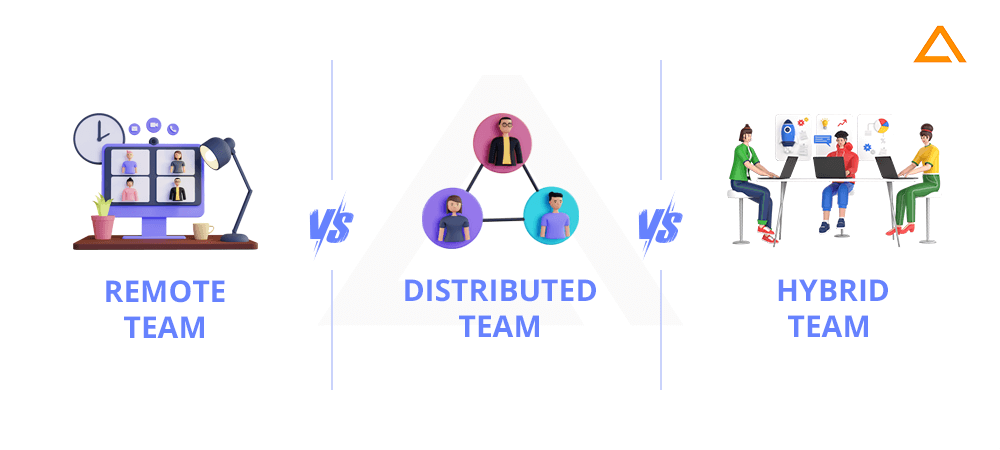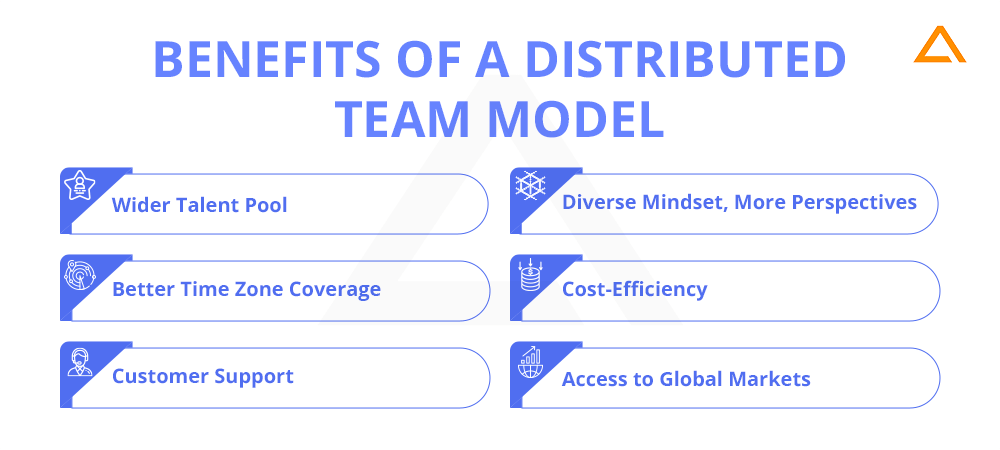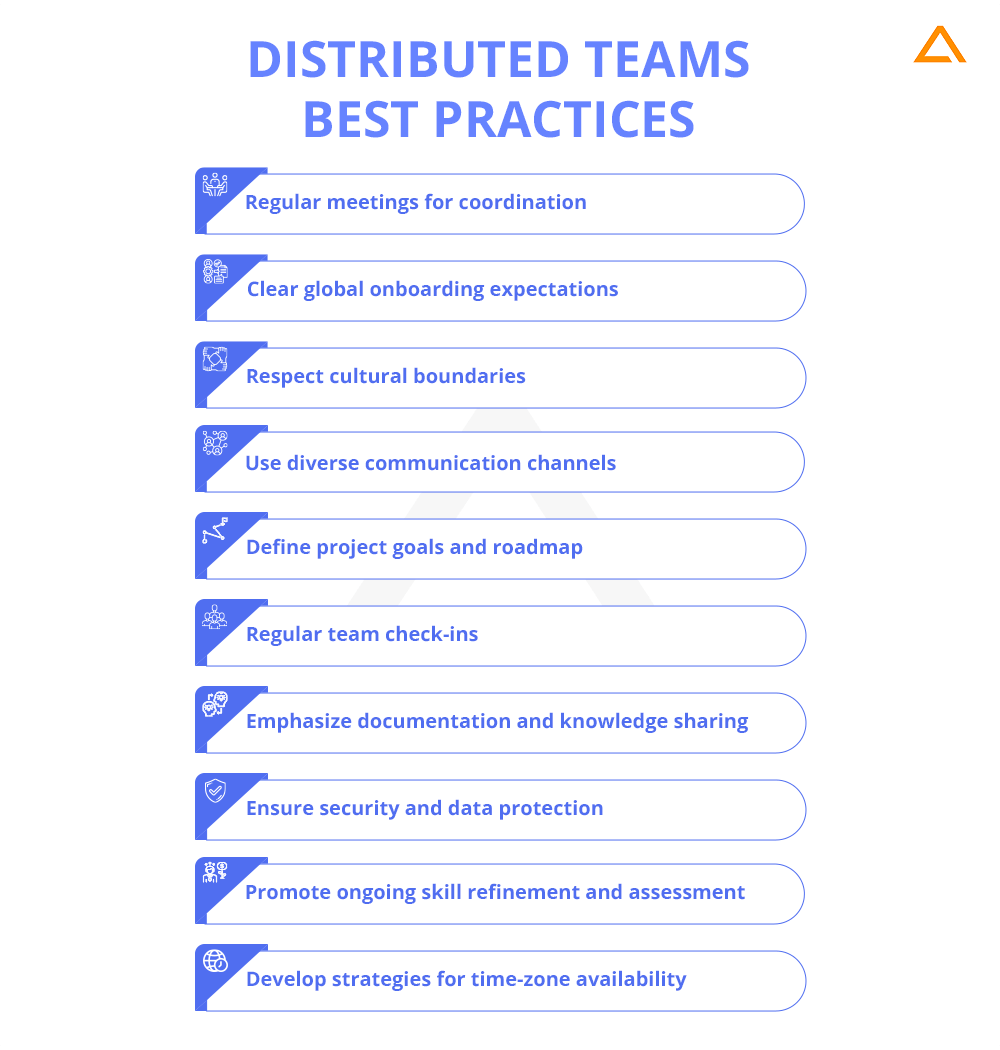Quick Summary:
Does managing distributed teams sounds like a nightmare? Need help with how to manage global teams? We have you covered. We will cover all the Distributed Workforce best practices, challenges and benefits and other important aspects to help you decide if distributed teams are the right choice for you or not.
- What is meant by distributed teams?
- How do you distribute a team?
- How do you manage distributed teams in Agile?
- How do you engage with a distributed team?
- What are the best practices for distributed teams?
- What are the challenges for distributed teams?
- How can we overcome the challenges in distributed teams?
Are these some of the questions that have been bugging you for quite some while now?
Not anymore.
This is your ultimate guide on managing distributed teams and everything you need to know about distributed team model and how it compares to alternates like hiring remote developers team or hybrid teams. This will help you evaluate if distributed teams are the right choice for you and how to optimally manage your distributed teams if you choose to go down this path. Without further ado, let’s dive right into it:
What is a Distributed Team?
Distributed Teams is a more proper phrase for global teams. You have various employees working from diverse and different physical locations.

Your distributed team could be spread across cities, countries or even at a much global scale. Unlike traditional co-located teams that share the same office space, distributed teams communicate and interact with other members via digital communication platforms and tools like Slack, Zoom, Trello and other important collaborative platforms.
Distributed teams gained popularity due to technological advancements, which have made remote work much more reliable, efficient and feasible. Businesses that hire distributed teams can offer employees better flexibility, significantly reduce overhead costs and provide round-the-clock services/support to their global clientele.
One important thing to note when efficiently managing global teams is that the core focus will remain the same as managing a large team in-house. However, the approach to achieving the same target will be significantly different and have challenges.
Difference between distributed team vs remote team vs hybrid team
| Types of Teams | Definition | Ideal For |
| Distributed Teams | Geographically dispersed team members with no physical office or headquarters. | ✦ Organizations that have a global presence ✦ Businesses with 24/7 coverage and support ✦ Companies seeking global talents |
| Remote Teams | Remote teams are also geographically dispersed team members, but they have one or more physical offices where some of the members might gather and work together. | ✦ Providing employees, the flexibility and work-life balance ✦ Projects where physical presence isn’t important |
| Hybrid Teams | Hybrid Teams are a combination of on-site and off-site remote team members. Some employees, known as the ‘core team’, work from a central office, whereas other remote developers or teams work from different locations. | ✦ Organizations with an in-house team want to extend and expand their team & operations ✦ Companies are looking for talents that can work closely with the on-site team |

Most people use these terminologies interchangeably, which is not right, as you can tell by now. Properly understanding a managed distributed or remote and hybrid model can help you gain more assurance on the path you want to take for your team-building requirements.
Why do organizations have distributed teams?
For several reasons! The concept and the culture for distributed teams have gained worldwide acceptance and is now being by more and more companies. The massive change is also mainly due to the contribution of advanced, reliable and secure communication channels and the overall changes in work culture.
Here are the various benefits of a distributed team model:

1. Wider Talent Pool
One of the biggest benefits of managing global teams is the freedom for organizations to hire and work with global talents worldwide without worrying about their physical or geographical locations. This allows the business to seek experienced and skilled developers indeed and expand their search beyond geographical confinements like their own city, country or continent, too, for that matter.
2. Better Time Zone Coverage and Customer Support
Round-the-clock productivity is possible, and that too without tormenting any of your resources to work extra or odd hours. If you genuinely want to build a global team, your team members will be from slightly or majorly differing time zones from each other. Hence, you can assign tasks and duties and work on working hours so that someone is always available to take customer queries or work on your project.
3. Diverse Mindset, More Perspectives
One of the key advantages of having access to a global team is the different mindsets or approaches they would bring to the table regarding the same challenge, opportunity or any important decision. This can significantly enhance the decision-making and coming up with innovative solution capabilities of the entire team.
4. Cost-Efficiency
By opting for a distributed team, you can save considerable money as they don’t require a physical office space, utilities or any other overheads associated with maintaining a physical office.
5. Access to Global Markets
Since your employees are based in different locations, countries and continents, you get better and more valuable insights into global markets, cultures, preferences and market dynamics. This can be instrumental for businesses that want to explore or venture into newer international markets.
Also Read: – Dedicated Team vs Staff Augmentation vs Extended Team Model
Managing Distributed Teams – Distributed Workforce Best Practices
Distributed workforce is one of the most prominent approaches to handle employees working remotely from different locations. However, managing such a distributed and dispersed team can be extremely challenging, especially without careful planning, access to collaborative tools and the idea of some distributed team management best practices.
Here are some of distributed teams best practices that can help you leverage the most benefits out of this approach:

1. Conduct Regular Meetings
We know, we know… you don’t want to be that manager/boss that forces employees to attend a Zoom meeting in the middle of the work. But we insist you give it a try! Regular virtual meetings can work wonders to help your team connect, align and focus on their daily and overall targets.
Make this meeting more like a discussion where employees can share their challenges and doubts, give important updates, or discuss ongoing projects. Also, one-on-one feedback can help remote talents feel valued and motivated if you have a smaller team or enough managerial positions.
2. Clear Expectations during Global Talent Onboarding
This is very important. When onboarding a selected or hired remote developer, you need to make sure that you clearly define and structure the roles and responsibilities, performance expectations, deliverables and work culture for them. Having clarity on such topics can help smoother the transition of new talents to your existing distributed teams, enabling them to contribute sooner to the business objectives.
3. Respect Boundaries and Cultural Beliefs
When managing global teams, one of the biggest challenges can be to be consciously aware of your international team’s cultural backgrounds and belief systems. Provide a friendly and welcoming environment in your team and integrate specific guidelines in the management for accommodating such cultural norms within your group.
4. Make use of multiple communication channels
Managing a global team requires establishing prominent and reliable communication channels. Different communication channels address different issues of your international teams like:
- Video conferencing for face-to-face communication – ideal for group or individual discussion
- Instant Messaging for quick and informal exchanges – ideal for real-time collaboration
- Email for longer, detailed and essential messages – ideal for notices, employee problem addressed
- Project Management tools for tracking task and project updates – ideal for work management and communication
5. Clearly Define Project Goals and Roadmap
One of the driving forces that ensures smooth cooperation and efficiency in the workforce between a global team comes from clearly defined project goals and a well-defined roadmap to achieve those goals. When you clearly define the project requirements and expectations, you help align the efforts of your global team towards a single purpose.
When you follow Agile management methodologies like SCRUMs and Sprints, each remote talent better clarifies what’s expected of them and when. This creates a sense of clarity among the employees, promoting accountability and responsibility for their key duties. It also enables them to monitor their progress and celebrate their achievements with the team.
6. Check-in with your teams and employees
Regular check-ins with your global team is a critical distributed IT team management best practice to keep track of their well-being and needs being met. Check-ins are different than official meetings and are an excellent way to ease that formal bond between a team lead and their subordinates. By providing a comfortable environment and trust, you can give employees a platform to raise their concerns, seek guidance and receive proper feedback. Moreover, it gives you a better idea about team insights, identifying potential issues and addressing challenges your teams face.
7. Documentation and Knowledge Sharing
Encourage your employees to be in the habit of properly documenting their work processes and solutions. Having a centralized source of documentation shared across teams can make the overall development process much more efficient and make it easier for newer joiners to get a better idea about the project.
8. Establish Proper Security and Data Protection Measures
The biggest risk with managing a dispersed team is ensuring the security of sensitive business secrets and compliance with data protection guidelines. Implement and encourage using secured networks and VPNs when your remote team wants to access sensitive company information.
9. Promote Continuous Skill Refinement and Assessment
You should find new and innovative ways to ensure that the global teams are well aware of the latest market trends in their development platform and the overall industry. You can use monetary or non-monetary incentives to conduct training workshops, certification courses, or competitive code jams.
10. Implement strategies for ensuring time-zone availability
One of the biggest challenges with managing distributed teams has to be dealing with different time zones. Organizations need to implement proper strategies keeping in mind team members’ availability and figuring out a collaborative way to manage time zone availability. You could rotate meeting times once at all fixed intervals so different talents at different locations feel about the process. Another approach could be to provide flexible working hours, trusting employees to get their part of the work done and not binding them to a 10-6 work routine. This would increase their value and compassion for the organization and help them maintain their work-life balance.
Address your dedicated team hiring concerns today!
Get in touch with Aglowid IT Solutions
Best Tech Stack for Distributed Engineering Teams
| Distributed Teams – Tool Category | Tools/Services for Managing Distributed Teams |
| Collaboration/Communication | Slack, Microsoft Teams |
| Video Conferencing | Google Meet, Zoom, Skype |
| Version Control Systems | Git, SVN |
| Code Collaboration and Reviewing | GitHub, GitLab |
| Screen Sharing and Whiteboards | Miro, Screen |
| CI/CD Tools | GitLab CI/CD, Jenkins |
| Project Management | Trello, Asana, Jira |
| Documentation and Knowledge Sharing | Notion, Confluence |
| Cloud Services | MS Azure, Google Cloud Platform, Amazon Web Services |
| Security & Authentication | Multi-Factor Authentication, VPNs |
| Virtual Machine & Containers | Kubernetes, Docker |
| Monitoring & Logging | ELK Stack, Prometheus, Grafana |

These are some of the leading industry-approved communication platforms that have marked their name in their respective fields for easing and improvising the overall process of managing large teams. Ensure you access at least one of these platforms in all categories.
What are the challenges for distributed teams?
We need to identify the pain points and challenges that might cause hindrances in the efficiency of a distributed workforce. It is easy for things to go unnoticed at a macro level with a globally dispersed team. Your employees could be suffering from low morale, there might be project ambiguity, internal conflicts and other such challenges that might go unnoticed. Establishing an adequately distributed IT management framework is just the beginning of the process. You need to constantly monitor it and avert the challenges or possible threats continuously to ensure smoother operations between your global teams.
So, how can we overcome challenges in distributed systems?

Here’s how:
Overcoming Communication Barriers
Problem: Remote communication can lead to misinterpretations, misunderstandings and delayed responses.
Mitigation: Set up proper communication channels, encourage open discussions and features such as Zoom meeting recordings which the users can access to go through all essential points covered in the session if they are unsure.
Coordination & Scheduling
Problem: Coordinating and scheduling a common meeting time or working time across various time zones can be very challenging, and this can give rise to many conflicts.
Mitigation: Setting up and leveraging proper coordination and scheduling tools that shows individual team members availability across different time zones by integrating with their project management boards. This can help the management develop a justified meeting time for all employees or use strategies like rotational meetings to be fair for all remote talents in your team.
Lack of Face-to-Face Interactions
Problem: Since there are no face-to-face interactions, it can impact the efficiency of team bonding, trust-building and the ability to brainstorm ideas with other teams.
Mitigation: Conduct periodic team-building activities, and provide social hours or room for casual meetings to develop a sense of camaraderie within the workforce.
Technology Dependency and Unpredictable Power Outages
Problem: Reliance on technology can make the team vulnerable or ineffective during power outages or technical issues. This can disrupt work continuity, disturbing work productivity significantly.
Mitigation: Always encourage your team to have alternate power sources and internet access if possible. Create a clear list of protocols to be followed during such events so employees can self-initiate and reduce downtime as much as possible.
Time Zone Differences
Problem: Different developers working in different time zones can lead to delayed response times and halt important workflows, impacting the efficiency of real-time collaboration.
Mitigation: Plan the work timings to overlap, improving the communication gap significantly and enabling better collaboration. Make use of asynchronous communication to ensure the project experiences continuous progress.
Performance Monitoring and Supervision
Problem: Since there is no physical presence of a managerial employee to overlook their team’s performance, it can be challenging to keep track of employee performance or recognize outstanding contributions.
Mitigation: Establish proper performance metrics and milestones, check up on remote developers or team leads frequently to understand the project status and provide them with any help or feedback they need from your end.
Security and Data Privacy
Problem: A distributed network is more prone to data breaches, privacy concerns and other security risks, especially when accessing sensitive data remotely.
Mitigation: Implementing proper security protocols and methods like VPN, encryption, and multi-factor authentication and ensuring compliance with data protection guidelines.
Knowledge Transfer and Sharing
Problem: No proper documentation or proper logging of such important documents can lead to lesser documentation and knowledgebase, which can create hindrances in the day-to-day troubleshooting and onboarding of new talents.
Mitigation: Encourage best practices of documenting work on the go using reliable documentation tools and sharing all the documentation, resources and best practices at a centralized location that other team members can access to help them overcome the same challenges. Also, provide essential tutorials, knowledge guides and other formats to all employees as a responsible manager/owner.
Wrapping up!
With this, we conclude our Ultimate Guide & Best Practices for Managing a Distributed IT Team. Consider these pointers and honestly assess your project requirements, infrastructure capabilities and business nature before committing to such a model.
have a unique app Idea?
Hire Certified Developers To Build Robust Feature, Rich App And Websites
Also Check:





 Say
Say